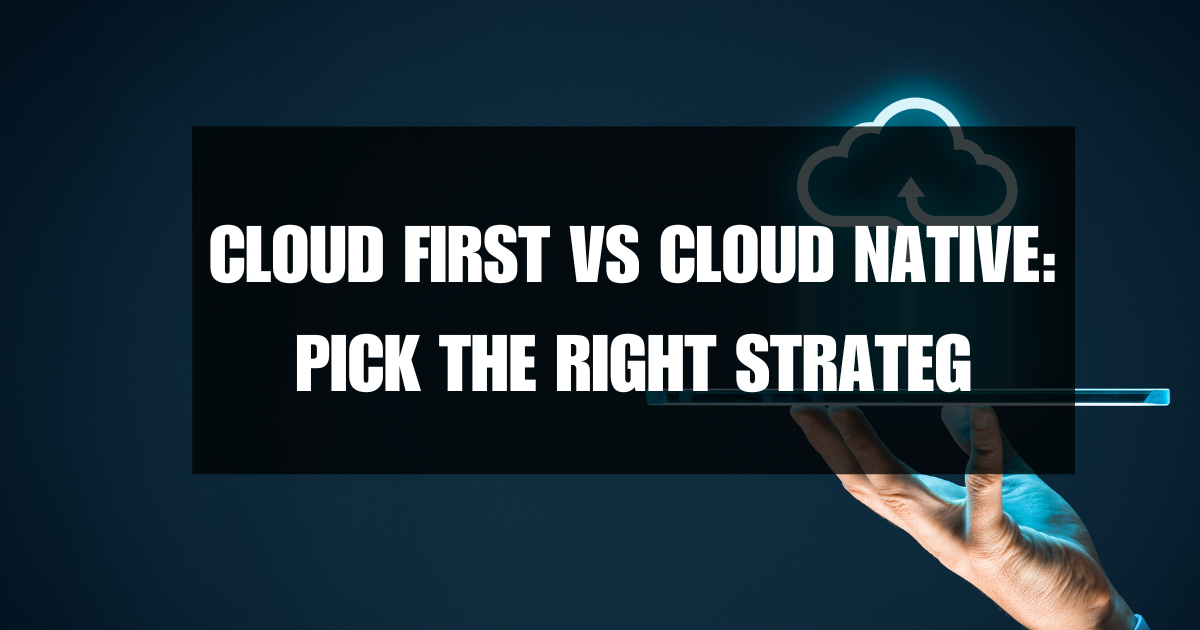Top 5 Tools to Master Vibe Coding in 2025

In 2025, the conversation around cloud computing has evolved dramatically. For many businesses, the cloud is no longer a goal—it’s the ground beneath every digital initiative. Yet, despite widespread adoption, one strategic question continues to shape how organizations modernize their infrastructure: Should we go Cloud First or Cloud Native?
The distinction between the two approaches is more than just terminology.
Cloud First emphasizes migrating existing systems to the cloud as efficiently as possible, while Cloud Native focuses on building new systems designed to leverage the cloud’s full potential. Choosing between them influences cost, speed, scalability, and innovation.
As technology leaders face rapid advances in AI, data analytics, and global collaboration, this choice becomes the foundation for how they build the future.
What Does a “Cloud First” Strategy Actually Mean?
If Cloud First is about adoption, then Cloud Native is about evolution. It represents a mindset that applications should be designed for the cloud, not just run on it. In a Cloud Native environment, systems are broken into microservices, each serving a distinct purpose and communicating through APIs. These services are packaged in containers and managed by orchestration platforms such as Kubernetes, enabling automatic scaling and fault tolerance.
Cloud Native applications rely on continuous integration and continuous deployment (CI/CD), meaning teams can test, update, and release code multiple times per day. The architecture supports self-healing, rolling updates, and near-instant rollbacks. This design is what enables global platforms like Netflix, Spotify, and Airbnb to deliver new features seamlessly to millions of users.
The approach requires greater expertise and cultural change, but it provides long-term flexibility, agility, and innovation. Where Cloud First gives companies a faster start, Cloud Native gives them sustainable momentum.
Why Does This Choice Matter So Much for Modern Businesses?
The rise of artificial intelligence, data-driven decision-making, and edge computing has intensified the need for dynamic infrastructure. Workloads are heavier, users expect faster experiences, and downtime is less tolerable than ever.
A Cloud First setup can host these workloads, but often inefficiently. It tends to over-allocate resources to handle spikes in demand, leading to wasted capacity and higher bills. In contrast, Cloud Native systems are elastic by design—they scale up and down automatically based on real-time load.
In industries where milliseconds matter, such as e-commerce, gaming, and streaming, Cloud Native systems offer a clear competitive advantage. But the transition isn’t purely technical—it reshapes how teams work, how budgets are managed, and how quickly innovation reaches customers.
What Are the Main Benefits of Adopting a Cloud First Strategy?
Cloud First remains an ideal starting point for organizations modernizing legacy systems. It provides a smooth path toward digital transformation without forcing a complete rewrite of existing codebases.
The key advantages include:
- Faster migration timelines: Companies can move critical systems to the cloud within months instead of years.
- Reduced hardware dependency: No more costly data centers or on-premise upgrades.
- Simplified governance: Cloud providers offer centralized billing, identity management, and built-in compliance tools.
- Immediate scalability: Storage and compute can expand or contract with minimal manual effort.
In essence, Cloud First is a bridge between traditional IT and modern cloud operations. It offers immediate wins while buying time to plan deeper modernization.
What Limitations Should Businesses Expect from Cloud First?
The biggest drawback of a Cloud First strategy is that it often preserves old inefficiencies in a new environment. Applications that weren’t designed for distributed systems can become difficult to scale or update. Costs may creep up when virtual machines run continuously without optimization. Vendor lock-in is another risk, as organizations rely heavily on one provider’s tools or pricing model.
Over time, many teams discover that Cloud First is a temporary stage—a stepping stone toward a more flexible and automated architecture. Without refactoring or redesigning applications, businesses risk maintaining the same technical debt, only with different servers.
How Does a Cloud Native Approach Transform Businesses?
Adopting Cloud Native principles is like rewriting the script of your entire IT operation. It shifts organizations from monolithic releases to continuous improvement.
Applications become modular, resilient, and observable. Developers can isolate and fix a single feature without bringing the entire system offline. Automated testing and deployment pipelines speed up time-to-market, while container orchestration handles scaling and resilience behind the scenes.
Culturally, Cloud Native encourages collaboration between development and operations teams. The DevOps mindset replaces silos with shared ownership, enabling teams to respond to issues faster and innovate more confidently. The payoff is agility—an organization that moves as fast as its customers do.
Which Approach Aligns Best with AI and Data Workloads?
The growing demand for artificial intelligence and machine learning in 2025 makes this decision even more important. AI workloads require massive compute bursts and rapid scaling, which are naturally suited to Cloud Native architectures. Containerized environments allow machine learning models to train and deploy efficiently, using resources only when needed.
In contrast, Cloud First environments can support AI, but often with manual provisioning and higher idle costs. Data-intensive platforms like Snowflake or Databricks, which thrive on elasticity and distributed compute, integrate more seamlessly with Cloud Native ecosystems.
Ultimately, companies building real-time data pipelines, predictive analytics, or AI-powered applications will gain more agility from Cloud Native design. Businesses focusing on stability and predictable workloads may find Cloud First sufficient for now.
How Can Businesses Transition Between the Two Models Successfully?
Moving from Cloud First to Cloud Native requires planning, visualization, and communication. Many organizations underestimate the complexity of refactoring legacy systems. That’s why mapping dependencies visually before migrating is essential.
Tools like MindMap AI by 3AxisLabs simplify this process. Teams can create interactive mind maps showing which applications to migrate first, which dependencies exist between services, and where refactoring offers the greatest ROI. A visual blueprint aligns technical and non-technical teams, reducing confusion during transformation.
A successful transition typically includes five phases:
- Audit existing applications for dependencies and performance bottlenecks.
- Define business outcomes that measure success—cost, speed, innovation.
- Run a pilot project to test governance and automation.
- Invest in training and automation, particularly DevOps and CI/CD tools.
- Refactor iteratively, applying Cloud Native principles to one service at a time.
What Is the Smartest Path Forward for Businesses in 2025?
The decision between Cloud First and Cloud Native is not binary—it’s sequential. Cloud First offers speed and simplicity; Cloud Native delivers resilience and agility.
Most organizations succeed by blending the two: migrating fast, then modernizing deeply.
In 2025, the true differentiator isn’t just being “in the cloud,” but how intelligently you use it. The companies that plan visually, think long-term, and invest in people as much as technology will lead the next wave of digital transformation.
FAQs
1. What is the main difference between Cloud First and Cloud Native?
Cloud First focuses on migrating existing systems to the cloud quickly—often with minimal changes to the original architecture. It’s about modernization through migration.
Cloud Native, on the other hand, is about building new systems designed specifically for the cloud. It emphasizes microservices, containers, automation, and scalability from the start.
2. Which approach is better for businesses starting their cloud journey?
For companies just beginning their cloud adoption, Cloud First is usually the best starting point. It provides faster results, lowers infrastructure costs, and helps organizations modernize without rewriting every application. Later, as teams gain more experience, they can gradually evolve toward Cloud Native practices.
3. Why is Cloud Native ideal for AI and data-driven workloads?
Cloud Native environments support elastic scaling, container orchestration, and automated resource allocation—all crucial for AI and machine learning. These workloads often need massive compute bursts that Cloud Native systems can handle efficiently. Cloud First environments can run AI too, but typically with higher idle costs and less automation.
4. Can a business combine both Cloud First and Cloud Native strategies?
Absolutely. Many successful companies use a hybrid approach—migrating legacy systems under a Cloud First model while developing new services with Cloud Native architecture. This combination provides the speed of migration with the long-term benefits of agility and innovation.






